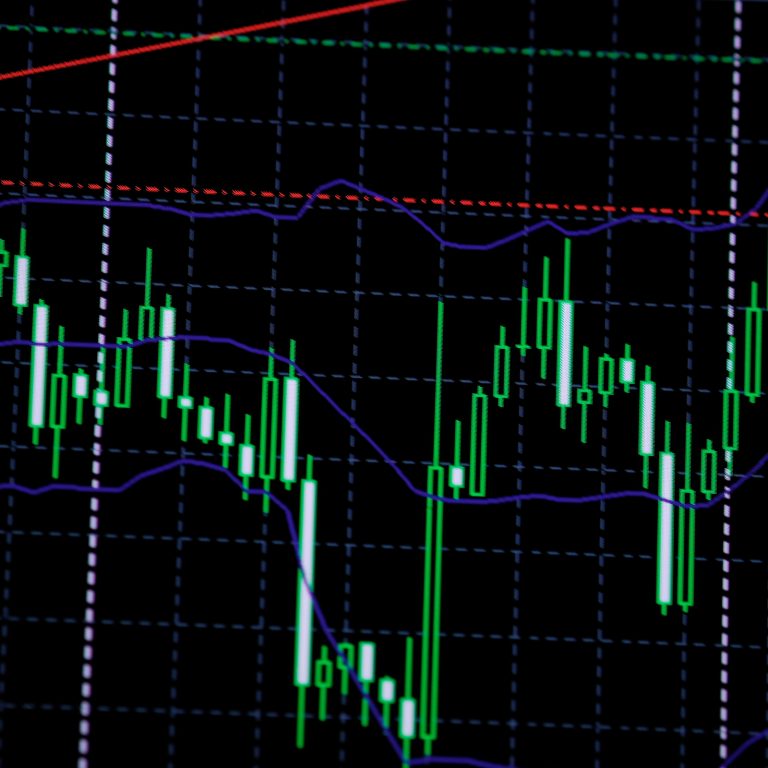2019-9-11 19:44 |
Introduction
This is the second of our 2-part series on technical indicators commonly used in trading cryptocurrencies. If you have not read our first article, click here for our first article which introduces Simple Moving Average, Relative Strength Index and Fibonacci Retracements.
In this blog post, we will explore a further three technical indicators that many traders use: Bollinger Bands, Moving Average Convergence Divergence (MACD) and On Balance Volume.
Bollinger BandsWe will first start with Bollinger bands. The Bollinger Band is made up of 3 lines based upon the 20 days simple moving average (“SMA”) of a cryptocurrency as well as a pair of lines reflecting a +/- 2 standard deviation points from the SMA. The SMA is a trend-following indicator that is calculated using past prices over a fixed time period, and you may wish to refer back to our previous article for a refresher. The use of moving averages to form the Bollinger Band was first developed and copyrighted by a famous technical trader called John Bollinger in the 1980s.
How to interpret Bollinger BandsThe closer the price of a cryptocurrency to the upper band, the more overbought the asset is. The inverse is also true: the closer the price of a cryptocurrency to the lower band, the more oversold the asset is.
Another key thing to look out for is the distance between the upper and lower bands. When the bands are “tight”, it implies a period of low volatility. When the bands are “loose”, it implies a period of high volatility. Note that Bollinger Bands are more useful when used in conjunction with other indicators.
How to use Bollinger Bands while tradingBollinger Bands applied on a DASH/BTC chart
Within the first box to the left of the price chart, we notice a significant decrease and increase in price which increases volatility and loosens the Bollinger Band. The period of high volatility is followed by a period of low volatility with prices trading sideways as demarcated by the second box to the right of the price chart.
Statistically speaking, the volatility of a cryptocurrency does not stay constant and would tend to oscillate between periods of high volatility and periods of low volatility. Large price movements are usually expected in moments of high volatility while prices are expected to trade sideways when volatility is low.
In this instance, the Bollinger Band helps to identify which periods might have an upsurge in volatility. When combined with other technical indicators which predict price movements and trends (such as MACD and Moving Averages), the Bollinger Band may assist to further affirm or disprove expected price movements.
Moving Average Convergence and Divergence (MACD)Next, we turn to the Moving Average Convergence and Divergence (MACD). MACD is a trend-following momentum indicator which shows the relationship between the 12-period and 26-period exponential moving averages (“EMA”) of the cryptocurrency. The EMA is calculated with a heavier weightage on recent prices (in contrast to the Simple Moving Average, which takes the arithmetic average of prices over the specified time period).
How to interpret the MACDThe MACD indicator can be found on most charting applications and applying it will produce a graph below the price chart. The graph is made up of 3 components: the MACD line, the Signal line and the MACD histogram.
MACD technical indicator components (MACD Line, Signal Line and MACD Histogram)
Components that make up the MACD technical indicator:
MACD Line: The difference between the 12 day EMA and the 26 day EMA Signal Line: The EMA of the MACD line MACD Histogram: The difference between the MACD line and the Signal lineTogether, the three components of the MACD technical indicator form certain key patterns which assist to indicate future price movements for the cryptocurrency in question.
How to use MACD while tradingCrossovers between the MACD line and the Signal line indicate a strong price momentum. When the MACD falls below the Signal line, it is a bearish signal which suggests a downtrend in prices. When the MACD rises above the Signal line, it is a bullish signal suggesting an uptrend in prices.
Crossovers between the MACD and the centreline (at the 0 mark) also indicate price momentum. A move from negative to positive signals bullish intent while a move from positive to negative signals bearish intent.
MACD line and Signal line crossover on the MACD chart (BNB/BTC)
In the BNB/BTC price chart above, we see a bearish signal when the MACD line dropped below the Signal line, suggesting a possible drop in the value of BNB against BTC. This was confirmed subsequently by the downward price movement.
The term divergence is used to describe the situation where the MACD’s movement and the price movement of the underlying asset moves differently. This means that traders will have to look out for trends in both prices and the MACD concurrently. Essentially, there are two types of divergences: bullish and bearish.
Bullish Divergence occurs when there is a different pattern between the price and MACD (EOS/ETH)
A bullish divergence may mark the end of a downtrend. In this example, a bullish divergence happens when the cryptocurrency price records 2 lower lows that corresponds to two higher lows of the MACD. As you can see in the chart above, the EOS/ETH pairing’s MACD formed two higher lows, while its price formed two lower lows during the same time period, resulting in a divergent pattern. Subsequently, following the formation of the bullish divergence signal, EOS/ETH rallied upwards.
Example of a Bearish Divergence (MCO/ETH)
A bearish divergence may indicate a reversal of an upward trend. A bearish divergence happens when the cryptocurrency price records two higher highs that corresponds with two lower highs of the MACD over the same period. With reference to the MCO/ETH price chart above, following the formation of the bearish divergence signal, where the MACD forms two lower highs and the price forms two higher highs, the price of MCO dropped.
On Balance VolumeFinally, we turn to on balance volume (OBV). OBV is a momentum indicator that is based on the volume of the asset being traded. It was developed in the 1960s by Joe Granville who first introduced it in his book, Granville’s New Key to Stock Market Profits. Unlike most other indicators, OBV calculation is relatively simple and can be split into three distinct cases:
Case 1: Current closing price is above the previous close:
Current OBV = Previous OBV + Current Volume
Case 2: Current closing price is below the previous close price:
Current OBV = Previous OBV – Current Volume
Case 3: Current closing price equals the previous close price:
Current OBV = Previous OBV (no change)
OBV is usually displayed as a line for easy interpretation because the actual magnitude of OBV is not of much value. Instead, we look at trends in OBV to predict the direction of price movements.
How to interpret OBVOBV is based on the idea that volume movements precede price movements. As OBV is a momentum indicator, we need to identify divergences as these will precede major price movements.
A divergence occurs when a technical indicator (OBV in this case) and price are moving in opposite directions.
As mentioned above, a bullish divergence happens when the cryptocurrency price records two lower lows that corresponds to two higher lows on the OBV. A bearish divergence happens when the cryptocurrency price records two higher highs that corresponds with two lower highs on the OBV.
How do we use OBV to trade?Bullish Divergence forms when there is a different pattern between the price and OBV (BTC/USD)
The yellow trend line on the price chart shows price making lower lows while the blue trend line shows OBV making higher lows for the same period. This pattern indicates a bullish divergence. As we expect, there was a sharp increase in price, as circled, immediately after this period.
Bearish Divergence forms when there is a different pattern between the price and OBV (XRP/BTC)
Similarly, we can see a bearish divergence on this chart where prices are making higher highs (refer to the yellow line) and OBV is making lower highs (refer to the blue line) for the same period. The steep fall in price following this observation again corroborates with our bearish expectations.
By taking note of bullish and bearish divergences, you can identify potential entry and exit points.
Applying a combination of technical indicatorsLet us now look at a combined example which covers the three indicators above.
Combined Example: LTC/BTC
Example combining OBV, Bollinger bands and MACD based on a LTC/BTC 1 hour price chart.
Consider the example in the price chart above where we analyse LTC/BTC traded on 20/02/2019 using OBV, Bollinger bands and MACD.
First, let us look at OBV. The light blue trend line shows price hitting lower lows while the yellow line on OBV shows OBV reaching higher lows over the same time period. This is a bullish divergence and hence we expect the price to rise according to the OBV indicator.
The circled part (in orange) shows a crossover on the MACD where the MACD line rose above the Signal line, forming a bullish signal.This is another indication for us to infer that the price will rise.
Combining these two observations with the Bollinger Bands, we see that there was a period of lower volatility with sideways price movement that coincides with these observations. Hence, this provides a basis to infer that there is an impending relative large price movement on the assumption that periods of high volatility are expected to follow periods of low volatility.
Thus, there is a possibility that the price will rise sharply following these observations. As shown in the next part of the graph which is boxed in white, prices indeed rose after these signals were identified.
ConclusionOnce again, we would like to emphasize that technical indicators are still predictions at best and that actual price movement may differ from the indicators may suggest. You should always conduct thorough research before taking positions and take appropriate steps to mitigate risks.
With this we have come to the end of our 2-part series on technical indicators. If you like the look and the feel of the charts on this blogpost, check out Sigma by Hydra X. Sigma is an advanced trading interface which gives you a simpler, easier way to manage your multiple crypto exchange accounts and execute trades across them. Enjoy the following features with Sigma:
Access to multiple major crypto exchanges (including Binance, Coinbase, Poloniex, Huobi and many more) Advanced Charting Tools (such as the charts used in this post) Quote Screen (for superior price discovery and arbitrage across multiple crypto exchanges) Watchlists, Portfolio Management, Live News, Social Chats (and many more features)Sign up for your free Sigma account now at: https://www.hydrax.io/sigma/ (do key in “CMCSIGMA” as your referral code)!
Disclaimer: This blog post does not constitute advice (legal, financial or otherwise) on any matter discussed and, accordingly, should not be relied upon as such. Hydra X does not make any representation or warranty as to the accuracy, completeness or correctness of the information or opinions set out in this blog post. Opinions expressed are subject to change without notice. This blog post does not have regard to the specific investment objectives, financial situation and the particular needs of any specific addressee, and Hydra X accepts no liability whatsoever for any direct, indirect and/or consequential loss (including any claims for loss of profit) arising from any use of and/or reliance upon this blog post.
The post Trading Cryptocurrencies: Commonly Used Technical Indicators (Part 2) appeared first on CoinMarketCap.
origin »Open Trading Network (OTN) на Currencies.ru
|
|










